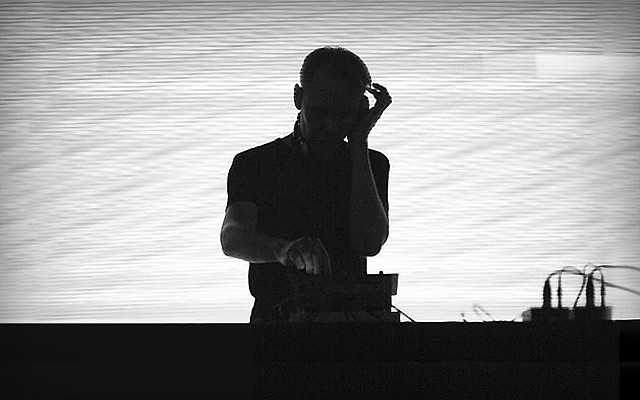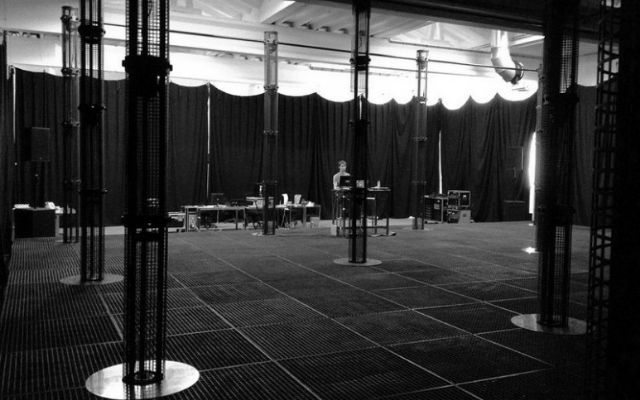It's About Intensity // Senking

Originally producing under the moniker Kandis, Jens Massel included a track on his debut release named ‘Senking’, a title and a sound which has come to define his most influential project. Under this moniker, Massel has become a veteran of Carsten Nicolai’s legendary Raster Noton imprint, well-known for his glacial, abyss-dwelling take on techno and the more minimal strands of dubstep.
Having finished his most recent tour, we caught up with Massel to discuss his connection to the UK, the use of hardware, and the ‘4D Soundsystem’.
So you just finished your tour of South Asia - how was that?
Great and exhausting! Now the cold I’ve been carrying around for the last four weeks really wants to get out..**
**
I noticed that they showed the film, “I Dream of Wires” about analogue synthesis at the ADE festival in Amsterdam, have you seen it?
Actually I watched the long version before the festival (I think around about four hours) and was very surprised to find myself in it (laughs).
You didn’t know you were in it?
It’s more like I forgot (laughs). I mean it wasn´t an interview or anything like that. They filmed us while we played around with all these very cool machines and Bill from the studio mentioned my name. But I’m happy to be part of it. This goes back a few years when we had a recording session with the guys in Hamilton (close to Toronto). Dean who has all this old analogue stuff set it up for us. I remember they mentioned this documentation, but, they weren’t sure if it really would happen.
Do you use much hardware yourself?
No, not much hardware at the moment, but I’m planing on getting more into it again. I like to change my set up every once in a while to come up with new ways of working, and to become less repetitive. I´m noticing more and more that I’m starting to miss using hardware. I never had any old analogue stuff but I always enjoyed connect all kinds of different machines via MIDI and getting inspiration out of the mistakes (laughs).
I understand you also performed a ‘4D Soundsystem’ set at the festival. Can you tell us a little bit about the set up there? How do they work? Who else is involved?
With the 4D soundsystem you can move the sound around the space in all kind of ways. Ok, this idea might not sound new, but in the case of the 4D system, for me it is. When I started working with the system, I immediately thought “yes, that´s exactly how I want my stuff to sound”. There are so many possibilities within the system, that my main problem in the beginning was to find a way to work with it, and in a way to limit myself, which in the end always is a good thing for me to do. Sometimes I just need time to find the discipline.
The sound of the 4D soundsystem works in a natural way, meaning there is sound underneath you, above you, passing by you and so on. In general you´re working with the space. If you´re interested in the whole idea and how it works in detail, I highly recommend you watch this video.
There are all kind of ways you can perform using the system. When you ask who else is involved, I want to say once more that the actual set I’m performing on the 4D system is not a set only by me, but by Paul Oomen (the 4D founder) as well. The set wouldn’t be the same without him - I brought the sounds and the composition’s, but as soon as we started to work on the details, Paul came up with so many great ideas that it really became a very fulfilling collaboration for me. I’m very happy with the result.

The 4D Soundsystem
I find it really interesting that people are exploring new ways to listen to music like with the 4D thing. What other frontiers do you think are still yet to be conquered in music?
It’s hard to tell for me. I like music - what it can do to you and your emotions etc. That’s why I loved it so much in the first place. To get there I think you´ll always need an idea for the composition, arrangement, sounds, lyrics etc. The 4D sound for example helps a lot when it comes to sound and dynamic for the Senking material I think.
But I also listen to music which is much better (of course only my personal opinion) when it comes across in a more lo-fi way. So when you ask about conquering music frontiers I think for me it´s about trying to get the most intensity out of different kinds of music. This can be done in a lot of different ways of course, but in general I think these methods haven´t changed too much. As I mentioned earlier, the idea of moving sounds isn´t new for me, we just got better with the techniques.
You’ve had a long connection with Raster-Noton who are now the primary outlet for your productions – when did you first meet Carsten Nicolai and how has your relationship changed over the years?
I met Carsten, Olaf and Frank sometime in 1999 when they played in my hometown, Cologne. They’d heard my Senking stuff before and liked it, so they asked if I’d be interested in being part of the “20 to 2000” series. Thorsten from “Karaoke Kalk” who released a lot of my stuff was very kind to introduce us.
Looking through your discography it appears there was a four year gap between Senking releases from 2003 – 2007, did you stop producing entirely during this period?
In this period the “Poto & Cabengo” was released on “Karaoke Kalk”. A CD/vinyl I made together with Michael Cramm. I´m still very happy about that release since the musically fusion between us worked out very well.
When it comes to Senking it was a time when I ran out of ideas, or let’s say I didn’t know how to develop the whole thing. I think one could call it a crisis!
There are quite a few crossovers between your sound and the dubstep scene which emerged across the noughties - did it have a big impact on you? Do you remember the first time you heard music of that genre? Is the UK close to your heart in this regard?
Yes, this had a very big impact on me. In fact in a way it helped me out of the 'musical crisis’ I mentioned earlier. I mean, it’s not like I want to make dubstep, but for sure you can hear the impact it had when listening to my recent releases. It’s another part of my sound. What I like so much about this kind of 'darker’ dubstep is that it is very minimal, slow, and it makes me dance all night long. I never thought music could do this to me.
This stuff played on a proper soundsystem makes me a happy camper (laughs). To put it in the words of Loefah “It’s just a big hole with some speakers”.
The first time I heard this stuff was when Loefah and Skream played in Cologne years ago - these days it’s getting harder to find the kind of events I really like. Everyone stays in while I’m checking out a dubstep party and a lot of the time it’s like "wow, this is dubstep? Maybe I got it all wrong.”
Messel is currently working on his ninth album as Senking, expected for release in 2015.
- Published
- Nov 16, 2014
.jpg)